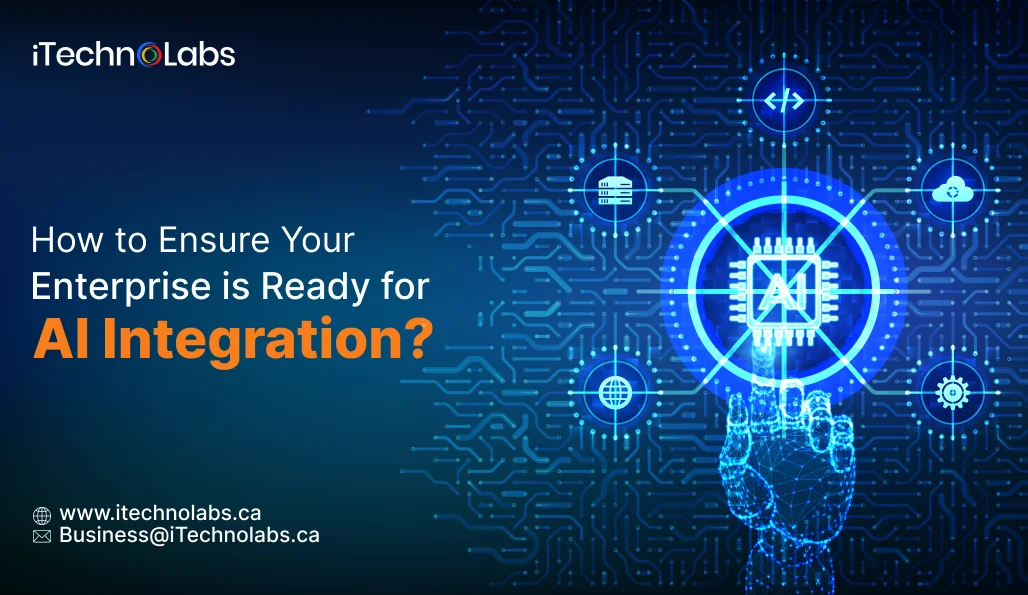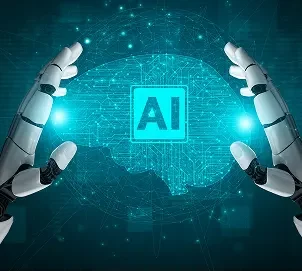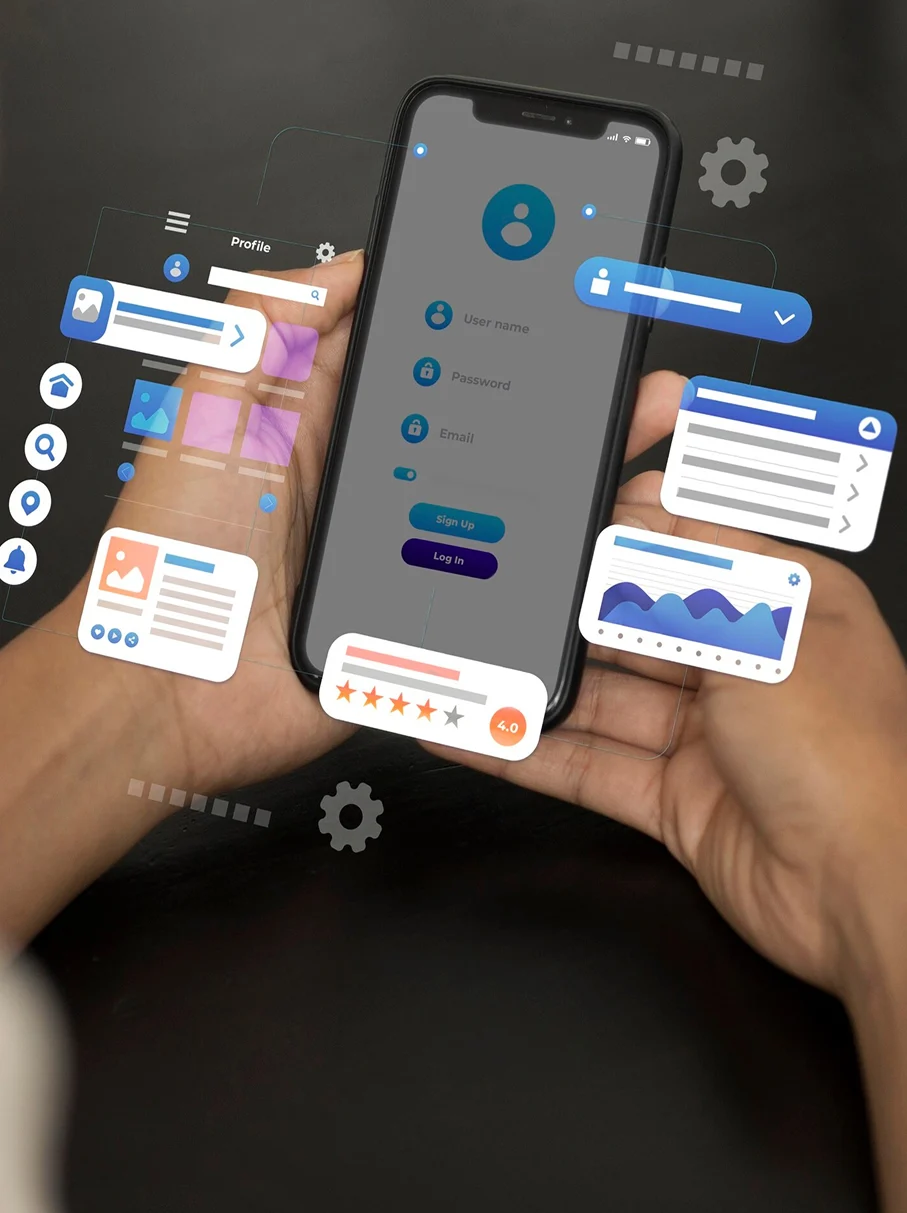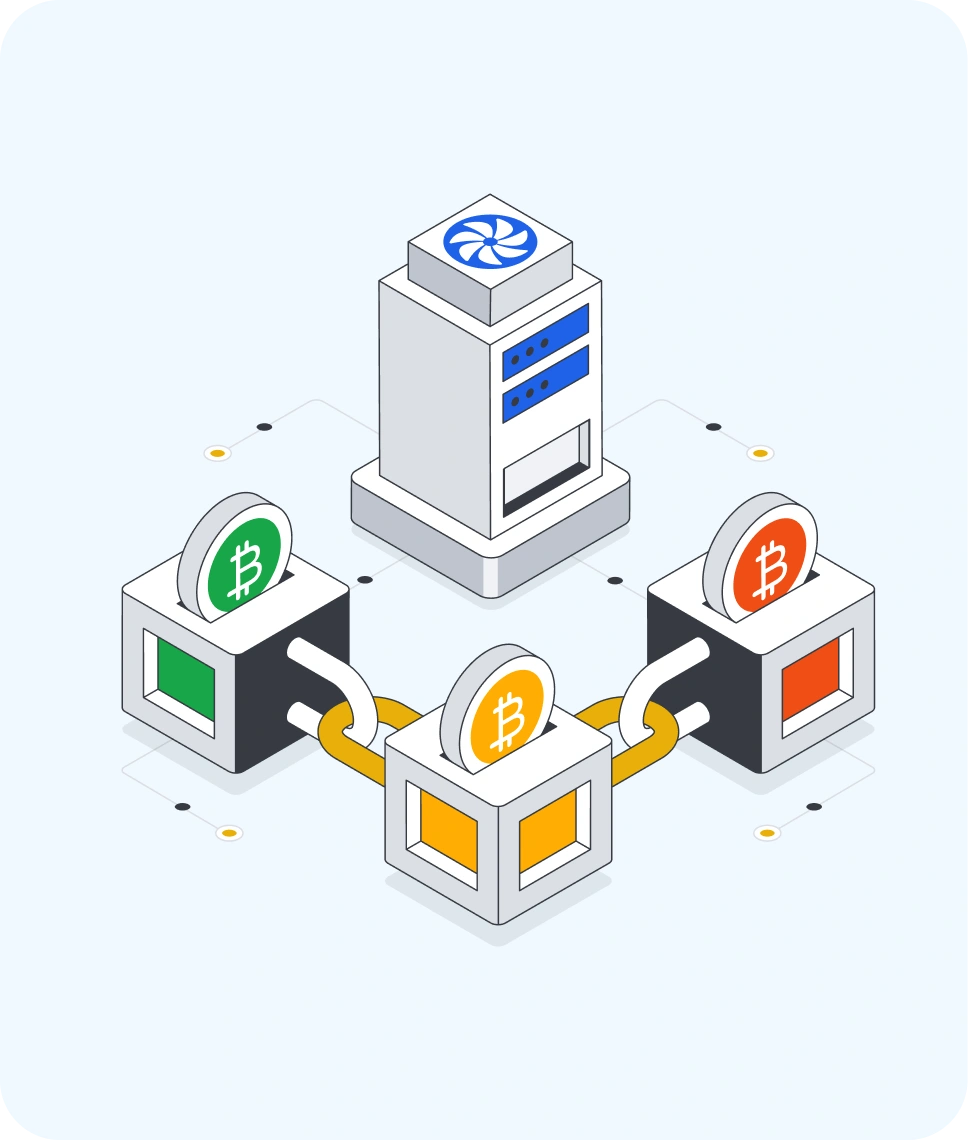Today, every business needs AI to speed up its processes, deliver better customer services, save time, improve the productivity of employees, and many other things. Only with AI integration can a business survive in today’s hyper-competitive world. AI models can do the work of multiple employees in less than half the time. This makes human employees free to focus on other high-priority tasks and achieve high levels of productivity. However, integrating AI into existing businesses is not that easy. Just like benefits, there are so many challenges one has to tackle while implementing AI in business. After overcoming the challenges, a company can fully use the potential of AI. Read this blog to learn what is AI integration, its benefits, challenges, and the step-by-step process to implement AI. Let’s get started.
Why do enterprises need AI integration?
AI is like a smart helper for businesses. It can look at lots of data fast. Businesses use AI to find useful patterns. These patterns help them make better choices. AI can also help in customer service. It can answer questions quickly without resting. Some companies use AI to predict sales. This helps them plan for the future well. AI can even help make ads smart. It shows the right ad to the right person. Workers can save time using AI tools. They can focus on harder, creative tasks. AI also helps in keeping data safe. It can spot problems before they get big. Many companies now think AI is important. It can make work faster and smarter. AI is changing how businesses work today. Using AI, companies can grow and improve.
AI integration in businesses helps to increase productivity and improve efficiency. Also, it helps to reduce costs, save time, and much more. In today’s time, using AI is not optional but a compulsion to survive. The business that still works on old models will be left behind. Only the organizations with AI implementation will be able to compete.
AI implementation is not just about using a chatbot or an agent. It’s more than that. It refers to the adoption of a complete AI framework to automate the daily tasks of all departments. By doing the work of 10 people alone in less than 1/4th of the time, AI makes employees free to focus on high-value tasks like future planning. According to McKinsey, 78% of companies were using AI for at least one of their functions. This clearly shows the increasing dominance of AI in industries globally.
Benefits of AI-Enabled Enterprise Integration
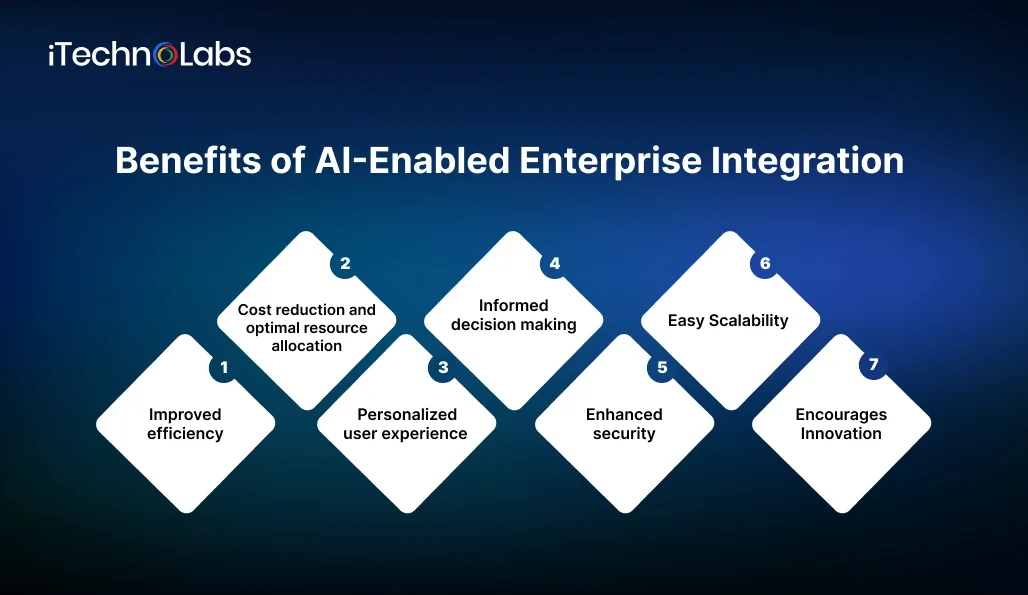
AI integration offers a wide range of benefits to organizations, because of which it is widely recognized by businesses globally. It provides advantages such as better efficiency, improved security, optimized resource allocation, lower cost, and more. Here are some of the best benefits of AI implementation:
1. Improved efficiency
With AI tools, departments can automate many of their repetitive tasks. This saves time for employees to do other activities that AI can’t perform. The automation helps to achieve high levels of productivity since employees get more free time than before. Also, AI tools can predict equipment failure in advance, preventing unnecessary repair costs.
2. Cost reduction and optimal resource allocation
When AI is doing the work of 10 employees, why do you need to hire more people? This means the businesses will get to save on hiring costs. Apart from this, AI can analyze the sales history, which helps the logistics to keep the exact right amount of stock in the godown. This presents overstocking and understocking.
3. Personalized user experience
AI helps businesses treat each customer specially. Chatbots give answers using customer history. Apps show content users like the most. This makes customers happy and keeps them coming back. Happy customers mean more sales for the business. AI makes using apps easier and fun for everyone. Personal touch grows trust and loyalty fast.
4. Informed decision making
AI works on data.AI can look at lots of data fast. It shows businesses what customers like most. It can predict problems before they happen. AI also helps plan money for the future. Businesses use it to stay ready.
5. Enhanced security
AI can watch people’s movements all the time. It helps keep places safe from danger. If something strange happens, AI tells the team. The team can act before problems grow. AI also works on computers to stop attacks. It keeps both real and digital places safe.
6. Easy Scalability
As compared to scaling by growing human employees, growing with AI is quite affordable. That’s because a company doesn’t have to increase the headcount at all. By upgrading the AI plans, companies can automate more of their tasks and optimize the processes without increasing the number of employees.
7. Encourages Innovation
AI helps businesses become more creative and smart. It studies data and finds new ideas fast. This helps people think of better ways to work. AI can design new products or improve old ones. It also helps solve problems quickly and easily. With AI, workers can focus on fun and creative tasks. It saves time and reduces boring work. Businesses can try new things without fear. AI helps them learn what works best. This makes the company grow faster and stronger. AI and people together can create amazing new things every day.
Technologies Powering the AI-Driven Future
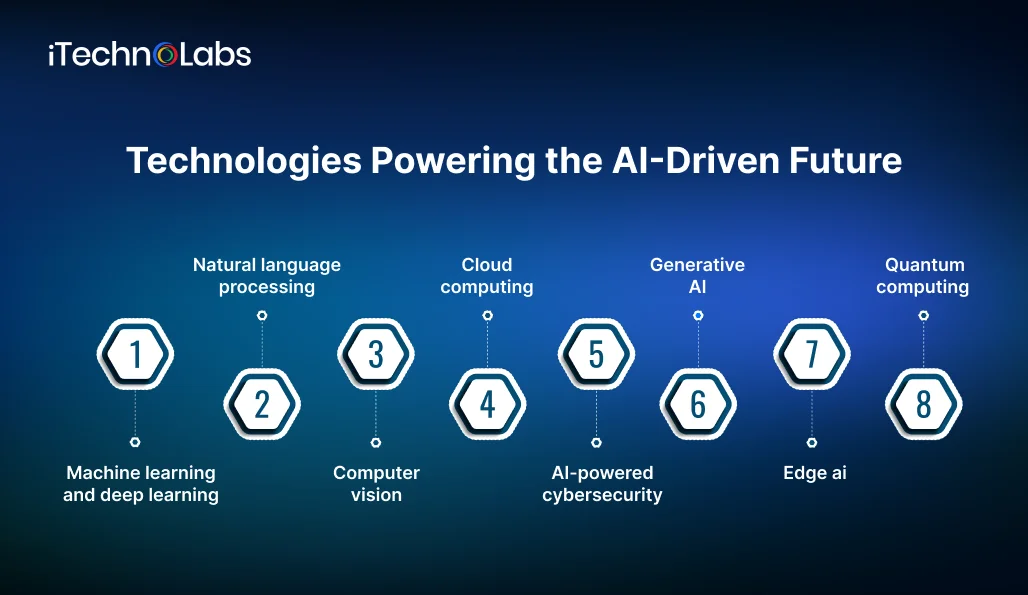
AI integration refers to using multiple technologies in a business. It’s not the work of a single model. For every different work, companies need a particular AI tool. Here are some of the most common AI technologies helpful in driving digital transformation in businesses:
1. Machine learning and deep learning
Machine learning (ML) is one of the branches of AI. It lets the computer learn from the data. Talking about deep learning (DL), it is a subset of ML that analyzes complex patterns and can mimic humans. The applications of ML and DL are predictive analytics, automated fraud detection, and AI-driven recommendation engines.
2. Natural language processing
Natural language processing, or NLP, helps computers understand human language. This is a game-changer for automation and customer engagement. The use cases of this technology are chatbots, sentiment analysis, and AI-powered content summarization. It is also used in translation apps, such as Google Translate.
3. Computer vision
Computer vision in AI integration enables computers to understand visual data, such as images and videos. The applications of computer vision are automated quality control, facial recognition, and AI-driven surveillance systems. It takes useful insights from objects and patterns. It uses technologies like machine learning and deep learning.
4. Cloud computing
Cloud computing refers to cloud infrastructure that provides the power to AI. With cloud computing, businesses can use AI without spending millions. The applications of cloud computing in AI are AI-powered predictive maintenance, smart traffic management, and Real-time analytics for fraud detection.
5. AI-powered cybersecurity
Unlike AI, it can monitor the systems 24*7 and detect any kind of spam or anomalies and inform the concerned team for swift action. It uses technologies like deep learning and neural networks, which are more effective than traditional machine learning. Its uses are AI-based anomaly detection, automated security monitoring, and biometric authentication.
6. Generative AI
Generative AI is the branch of AI that can generate content from text to images. By analyzing the existing content, it can learn to create new content. Its use cases are AI-generated marketing content, automated design and prototyping, and AI-driven coding.
7. Edge AI
Edge AI is a smart technology. It lets devices think and act fast. Instead of sending data to faraway computers, it works right on the device. This saves time and internet use. For example, a phone can recognize your face quickly. Edge AI helps cars see roads and people safely. It also makes smartwatches check health instantly. This technology is used in robots, cameras, and many machines. It keeps information safer, too. Edge AI makes everyday devices smarter and faster. It helps people do tasks easily and safely.
8. Quantum computing
Quantum computing is a new kind of computer. It works faster than normal computers. It uses tiny particles called qubits. These qubits can do many things at once. This helps solve hard problems very quickly. AI and quantum computers work well together. They can learn, think, and make decisions faster. For example, they can find patterns in big data. They can also help make better medicines or weather forecasts.
Quantum computers are still being built and tested. Scientists around the world are learning more every day. In the future, they may help make AI much smarter. Quantum computing could change how we live and work.
Suggested article: Agentic AI in Banking: Use Cases That Drive Growth & Innovation
Step-by-step Process for AI Integration
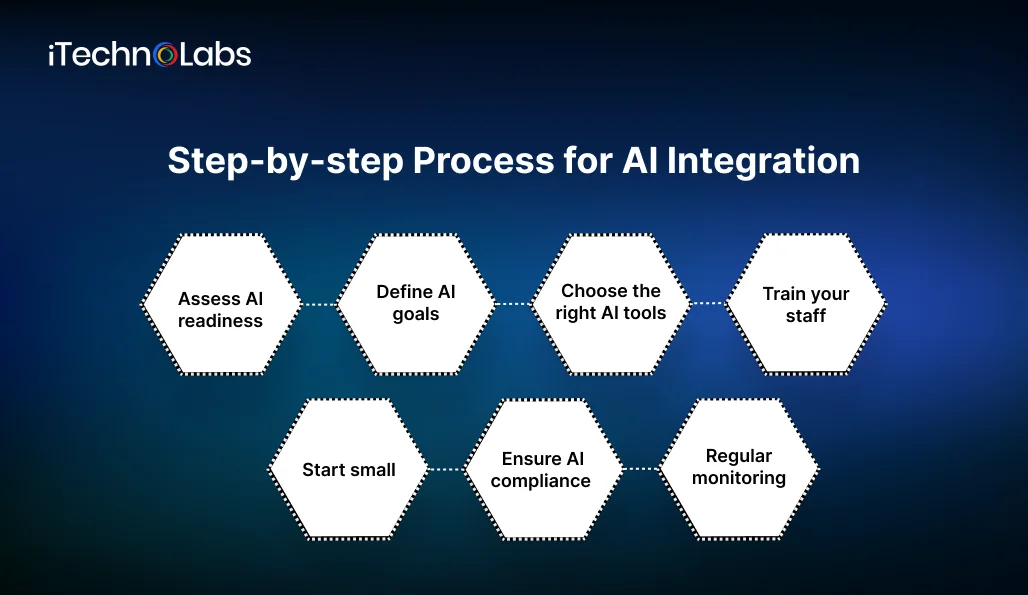
There is a step-by-step process to implement AI in your business. The AI integration process starts from assessing AI readiness, followed by defining AI goals, choosing the right AI tools, training staff, monitoring, and regularly updating AI technology. Let’s see the process to adopt AI in your business:
1. Assess AI readiness
Before moving to AI implementation, you need to evaluate your current system. Check if it’s compatible with the AI tools and framework. The system must be capable enough to do heavy computational work and analyze huge amounts of data.
2. Define AI goals
Without a clear goal, you won’t be able to move forward. Also, it will lead to a waste of time, money, and effort. You need to make strict KPI (key performance indicators). Ask yourself, what is it that you want to achieve? Do you want to automate tasks, reduce costs, save time, or anything else? Once your objectives are clear, you can easily find the way.
3. Choose the right AI tools
First, know what your goals are clearly. Next, pick the right AI tools for work. Not all tools fit every business. Wrong tools waste time and money. Learn about tools in the market. Find the one that fits your needs best. Make smart choices for better results.
4. Train your staff
No matter how advanced the technology you implement, it will be of no use if your own employees can’t use it. So the next thing is to train your employees on how to use AI tools for their daily work. Invest in their learning and they will give 4x to 5x returns than earlier. Conduct workshops and let them learn from AI experts and completely unleash the potential of AI.
5. Start small
You don’t have to go all in with AI integration. Firstly, implement AI in a single department. Once that starts showing desired results, then move forward with other departments and implement it throughout the organization. Do collect the feedback in the initial stages to correct any errors found.
6. Ensure AI compliance
AI can make mistakes. It can also lead to wrong results if the data is irrelevant or outdated. To tackle this challenge, the company has to implement strict regulations such as GDPR, CCPA, HIPAA, whichever is applicable in their country, sector, etc. conduct regular AI audits to find out any mistakes or errors it’s making. Implement an AI ethics framework and strengthen cybersecurity measures.
7. Regular monitoring
Lastly, you have to keep monitoring your AI model to ensure it’s working properly. You have to regularly improve it to make sure it remains competitive and sustainable. As per the changing AI trends, you would have to make some changes to your AI model. Keep upgrading it from time to time so that it will give you the best results.
Key Challenges in AI Implementation & How to Overcome Them
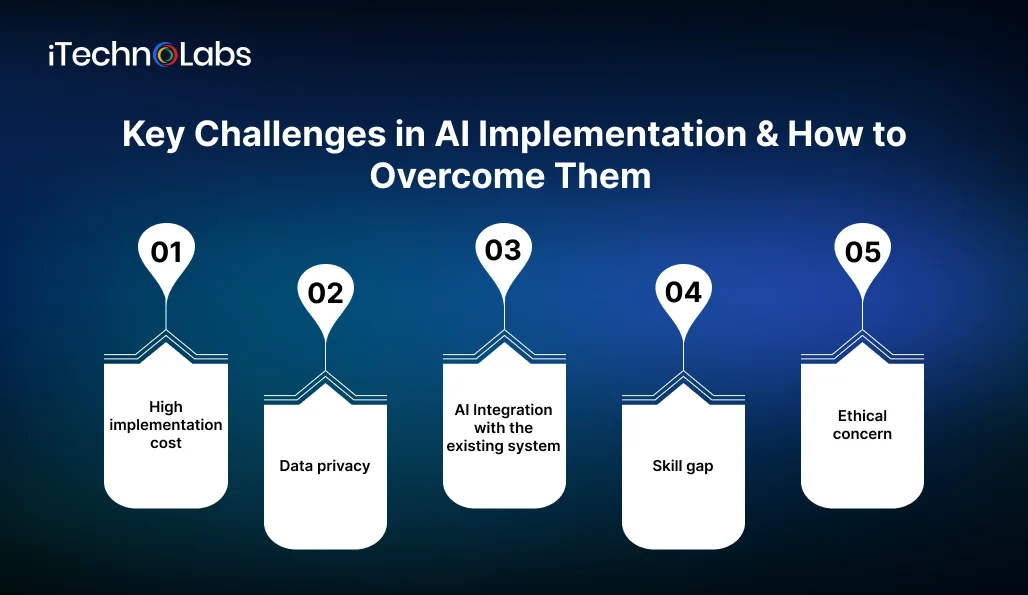
AI integration is not that easy; many challenges come in the way. Some common challenges are data availability, lack of skilled talent, high implementation cost, data privacy, and many more. Here are some of the challenges for AI adoption in a business and how to overcome them:
1. High implementation cost
Challenge: To implement AI, the business needs to invest a huge sum of money in hardware, software, and hiring skilled workers. Not all companies can incur such heavy costs, especially small-scale businesses.
Solution: Start with pilot projects before implementing AI in the whole company. Use cloud-based AI solutions to save on infrastructure costs. Partner with a professional AI development company for affordable AI solutions.
2. Data privacy
Challenge: The Next common challenge in AI integration is maintaining the privacy of the data. The AI tools are vulnerable to cybercriminals. Since they handle a lot of sensitive data of customers, companies can’t risk it. Data breaches are common problems in AI models.
Solution: The solution for this is to implement strict data governance policies to protect access to sensitive data. Consider using AI-powered cybersecurity solutions to detect and prevent threats in real-time. Also, you can work with AI integration services.
3. AI Integration with the existing system
Challenge: Most companies’ current infrastructure is not compatible with AI models. This is a big problem for many businesses. Replacing old systems with new AI models can be expensive and may take too much time.
Solution: To overcome this challenge, pick up the tools that can easily integrate into your exciting system. Use api API-based AI models for smooth integration. You can also use cloud-based AI solutions to save further costs.
4. Skill gap
Challenge: Finding the right people who possess AI literacy skills isn’t easy. The talent is scattered all over the world. Also, the current employees might resist learning AI, which worsens the problem. If employees aren’t AI-ready, then this can hamper the work.
Solution: Conduct AI training programs to teach employees AI skills. Promote AI throughout the organization and make the workforce understand that it’s for their benefit only. Tell them that it will increase their productivity and let them do more in less time.
5. Ethical concern
Challenge: Another big concern for many companies is to make sure the AI doesn’t deliver biased results. This may be possible if the data is inaccurate and irrelevant. The AI might discriminate, which can lead to unfair decisions.
Solution: Use a wide range of data sets to ensure the AI-generated results are bias-free and fair. Conduct audits from time to time to detect any wrong or errors in AI results. Make an AI ethics committee that will check the AI results and ensure it’s ethically right.
Also, read: Role of AI in Business Intelligence
Conclusion
Using AI can help your business win. It makes work faster and easier. AI saves time and cuts costs, too. Customers are happier with AI help. Businesses grow bigger and stronger. Everyone can use AI to do better. It gives you an important advantage. However, many challenges come in the way of AI implementation. These challenges are data privacy, high implementation cost, ethical issues, integration with existing systems, lack of skilled talent, and more. If you are also thinking of implementing AI, don’t worry, you can partner with a professional AI development company.
FAQs
1. What does AI integration mean?
AI integration refers to the implementation of AI technologies in the organization. This helps to increase productivity, enhance security, improve efficiency, reduce cost, and save time. AI adoption helps to automate tasks and make employees free to focus on value-driven activities.
2. What is an example of AI integration?
The AI integration examples can be found in almost every industry. However, the most popular AI integration examples are virtual assistants Siri, Alexa, and personalized recommendations on entertainment platforms like Netflix, Spotify.
3. How can I integrate AI?
The step-by-step process to adopt AI is as follows:
- Assess AI readiness
- Define AI goals
- Choose the right AI tech stack
- Train staff
- Start small
- Monitor regularly
4. What are the benefits of AI integration?
AI adoption provides various benefits to businesses, such as improving efficiency, automating time-consuming tasks, enhancing customer experience, reducing costs, and enhancing security.
5. How much does AI integration cost?
The AI integration cost depends on the type of models you want to get implemented. However, to give you an idea, the AI model integration may cost you $50,000 for basic chatbots, while for an advanced robot, it may cost you more than $100,000.

